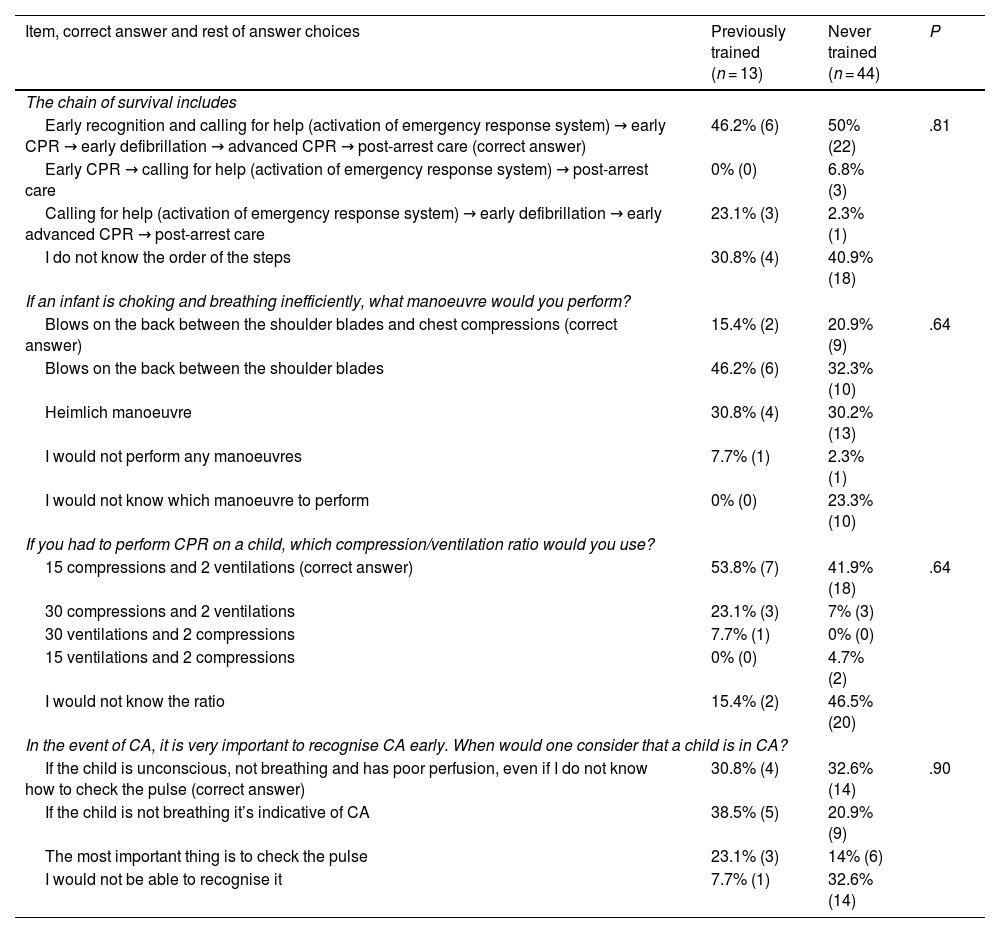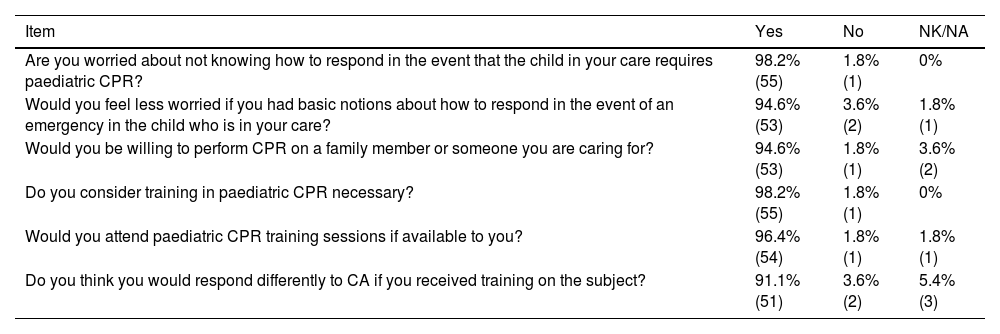In the paediatric population, out-of-hospital cardiac arrest (CA) is infrequent and, regrettably, survival is very low.1 Children with severe medical conditions are at increased risk of experiencing these events compared to their healthy peers.2 Adequate preparation can facilitate the adjustment of caregivers and increase safety after hospital discharge.2
The aim of our study was to assess parental perceptions regarding their need of training in basic life support (BLS), with the working hypothesis that they considered such training necessary, and for the purposes of developing a training programme.
We conducted a single centre cross-sectional and analytical study in the Department of Paediatrics of a tertiary care hospital. The statistical analysis was conducted with the R software package and the R commander graphical user interface (John Fox, McMaster University, Hamilton, Canada). The study was approved by the competent ethics committee (file code 2023/053).
We handed out a questionnaire to the carers of paediatric patients who visited the hospital for assessments or to receive medical care, recruiting a total of 57 participants. Of this total, 27 (47.4%) were in charge of healthy children, of who 5 (8.8%) had undergone training in the past. The number of respondents who cared for ill minors (including children who made follow-up up visits to outpatient clinics at least twice a year or receiving chronic treatment) was 30 (52.6%), of who 8 (14.0%) had been previously trained. Of all respondents, 77.2% had never been trained on BLS, even though 50% of them had a diseased child.
In the out-of-hospital setting, few medical emergencies involve children. However, an adequate response by the parents is crucial to reduce mortality and potential sequelae.3
The data collected in our study evinced substantial ignorance of concepts related to paediatric BLS. Table 1 presents the items in the questionnaire that asked about BLS, the responses to those items and the corresponding P values, while Table 2 presents the results regarding the perceived need of training.
Differences in training of parents of ill and healthy children.
| Item, correct answer and rest of answer choices | Previously trained (n = 13) | Never trained (n = 44) | P |
|---|---|---|---|
| The chain of survival includes | |||
| Early recognition and calling for help (activation of emergency response system) → early CPR → early defibrillation → advanced CPR → post-arrest care (correct answer) | 46.2% (6) | 50% (22) | .81 |
| Early CPR → calling for help (activation of emergency response system) → post-arrest care | 0% (0) | 6.8% (3) | |
| Calling for help (activation of emergency response system) → early defibrillation → early advanced CPR → post-arrest care | 23.1% (3) | 2.3% (1) | |
| I do not know the order of the steps | 30.8% (4) | 40.9% (18) | |
| If an infant is choking and breathing inefficiently, what manoeuvre would you perform? | |||
| Blows on the back between the shoulder blades and chest compressions (correct answer) | 15.4% (2) | 20.9% (9) | .64 |
| Blows on the back between the shoulder blades | 46.2% (6) | 32.3% (10) | |
| Heimlich manoeuvre | 30.8% (4) | 30.2% (13) | |
| I would not perform any manoeuvres | 7.7% (1) | 2.3% (1) | |
| I would not know which manoeuvre to perform | 0% (0) | 23.3% (10) | |
| If you had to perform CPR on a child, which compression/ventilation ratio would you use? | |||
| 15 compressions and 2 ventilations (correct answer) | 53.8% (7) | 41.9% (18) | .64 |
| 30 compressions and 2 ventilations | 23.1% (3) | 7% (3) | |
| 30 ventilations and 2 compressions | 7.7% (1) | 0% (0) | |
| 15 ventilations and 2 compressions | 0% (0) | 4.7% (2) | |
| I would not know the ratio | 15.4% (2) | 46.5% (20) | |
| In the event of CA, it is very important to recognise CA early. When would one consider that a child is in CA? | |||
| If the child is unconscious, not breathing and has poor perfusion, even if I do not know how to check the pulse (correct answer) | 30.8% (4) | 32.6% (14) | .90 |
| If the child is not breathing it’s indicative of CA | 38.5% (5) | 20.9% (9) | |
| The most important thing is to check the pulse | 23.1% (3) | 14% (6) | |
| I would not be able to recognise it | 7.7% (1) | 32.6% (14) | |
CA, cardiac arrest; CPR, cardiopulmonary resuscitation.
Perceived need of training in parents.
| Item | Yes | No | NK/NA |
|---|---|---|---|
| Are you worried about not knowing how to respond in the event that the child in your care requires paediatric CPR? | 98.2% (55) | 1.8% (1) | 0% |
| Would you feel less worried if you had basic notions about how to respond in the event of an emergency in the child who is in your care? | 94.6% (53) | 3.6% (2) | 1.8% (1) |
| Would you be willing to perform CPR on a family member or someone you are caring for? | 94.6% (53) | 1.8% (1) | 3.6% (2) |
| Do you consider training in paediatric CPR necessary? | 98.2% (55) | 1.8% (1) | 0% |
| Would you attend paediatric CPR training sessions if available to you? | 96.4% (54) | 1.8% (1) | 1.8% (1) |
| Do you think you would respond differently to CA if you received training on the subject? | 91.1% (51) | 3.6% (2) | 5.4% (3) |
CA, cardiac arrest; CPR, cardiopulmonary resuscitation; NK/NA, does not know/does not answer.
Half the parents were not able to determine the correct order of the steps of the chain of survival. In addition, 23.3% would not know what to do in the event of airway obstruction, nearly half could not determine the adequate ventilation/compression ratio and 32.6% would not know how to recognise CA. Previous studies have led to the same conclusions, evincing the need to establish BLS training strategies.
Of all respondents, 98.2% (n = 56) expressed concern that they would not know how to respond to an emergency and considered they needed training on paediatric BLS. In addition, they stated that if they had basic notions of BLS they would feel less worried. A study by Tomatis et al.4 produced similar findings and demonstrated that training of parents significantly increased their knowledge and confidence.
Of those who had received previous training, 61.5% (n = 8) rated their level of knowledge as fair, 30.8% (n = 4) as good and 7.7% (n = 1) as poor. In addition, 84.6% (n = 11) considered that intervention in this area was necessary.
We did not find statistically significant differences in the frequency of previous training on paediatric BLS between the caregivers of ill children and those of healthy children (P = .46), nor in the mean scores obtained by caregivers who had received training versus those who had not (P = .88).
Of all the parents, 96.4% (n = 54) stated they would attend training sessions on paediatric BLS, without statistically significant differences between parents of ill children and parents of healthy children (29/30 vs 25/25 would attend trainings; P = .36).
Respondents considered that the best possible setting to be trained on BLS would be health care facilities (57.1%; n = 32) followed by schools, contrary to other studies in which schools were considered the best possible option.5
The limitations of the study derive from its design, the recruitment in a hospital setting and the self-reported information on previous training, but, given its objectives, this methodology facilitated the performance of the study and allowed us to assess the willingness of families to receive training.
The caregivers of paediatric patients managed in a tertiary care hospital expressed a need to be trained in paediatric BLS. We found a substantial lack of knowledge regarding the identification of CA, the chain of survival, the management of airway obstruction and the CPR compression/ventilation ratio. Therefore, we consider it necessary to develop a training programme covering these aspects.
FundingThis research did not receive any external funding.
Conflicts of interestThe authors have no conflicts of interest to declare.






